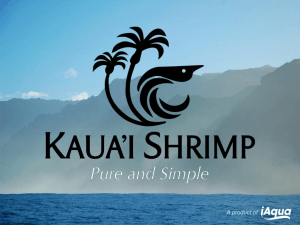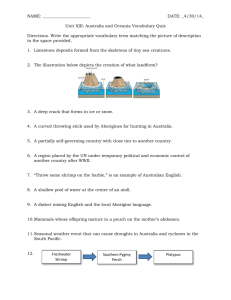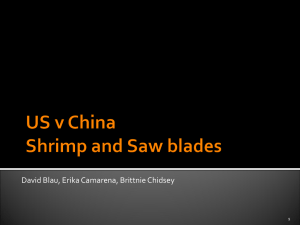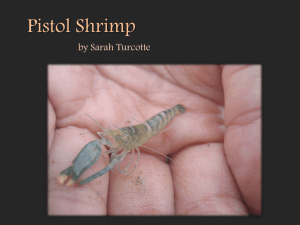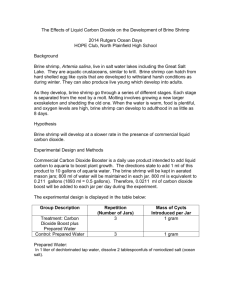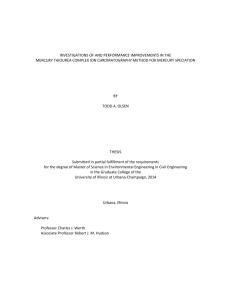etc2888-sup-0001-SupInfo-S1
advertisement
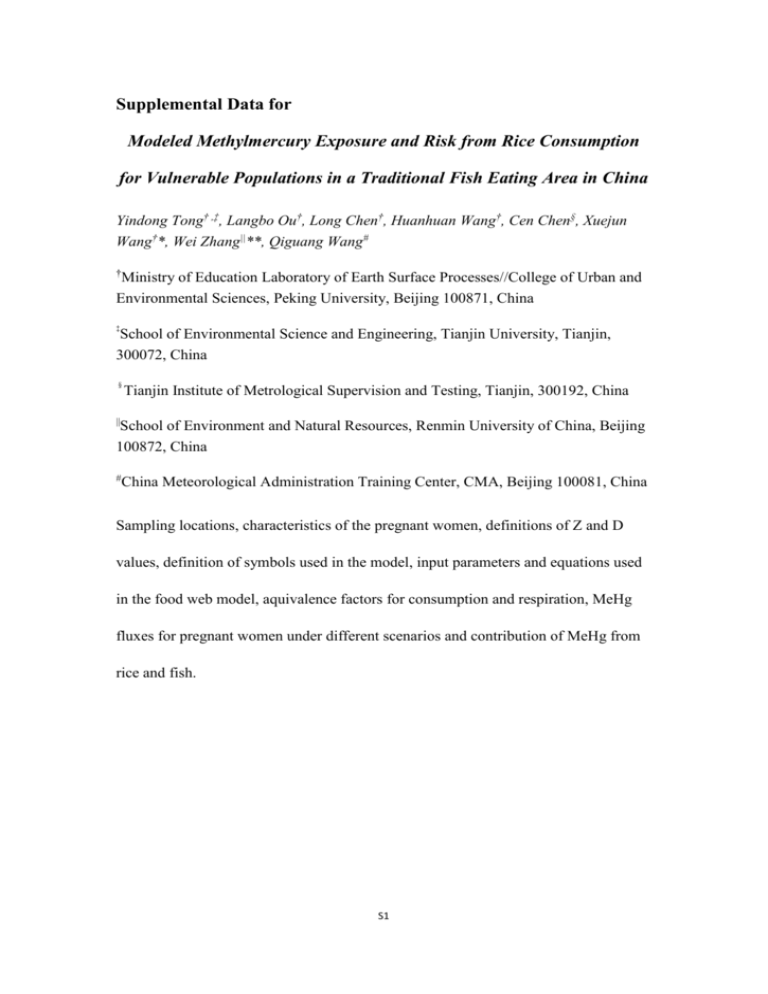
Supplemental Data for Modeled Methylmercury Exposure and Risk from Rice Consumption for Vulnerable Populations in a Traditional Fish Eating Area in China Yindong Tong† ,‡, Langbo Ou†, Long Chen†, Huanhuan Wang†, Cen Chen§, Xuejun Wang†*, Wei Zhang||**, Qiguang Wang# † Ministry of Education Laboratory of Earth Surface Processes//College of Urban and Environmental Sciences, Peking University, Beijing 100871, China ‡ School of Environmental Science and Engineering, Tianjin University, Tianjin, 300072, China § Tianjin Institute of Metrological Supervision and Testing, Tianjin, 300192, China || School of Environment and Natural Resources, Renmin University of China, Beijing 100872, China # China Meteorological Administration Training Center, CMA, Beijing 100081, China Sampling locations, characteristics of the pregnant women, definitions of Z and D values, definition of symbols used in the model, input parameters and equations used in the food web model, aquivalence factors for consumption and respiration, MeHg fluxes for pregnant women under different scenarios and contribution of MeHg from rice and fish. S1 Figures Figure S1. Sampling locations of this study S2 Tables Table S1. Definitions of Z and D Values Definitions of Z and D Values Z values Water ZW = 1.00 Assumed Lipid ZO = KowZW KOW = octanol water partition coefficient Nonlipid organic matter ZN = KB.ρBZW KB = bioconcentration factor (L/kg) ρB = organism density(kg/L) Fish/organism ZF = FLZO + FNZN+ FWZW Food ZA = ZF FL = lipid fraction FN = nonlipid organic fraction FW = water fraction ZA = assumed to be the Z value of its prey D values Chemical exchange GW = gill ventilation rate (m3/h) DW = GWEWZW through respiration EW = efficiency of chemical transfer across gills Net chemical intake D A = E DG D Z A ED = gut absorption efficiency GD = food ingestion rate (m3/h) from food Growth dilution DG = VFZFkG kG = growth rate (/h) VF = volume of the organism (m3) Chemical loss by DE = DA/LB LB = limiting biomagnification factor DM = VFZFkM kM = metabolic rate (/h) excretion Chemical loss by metabolism S3 Table S2. Definition of the symbols used in the model1 Parameter Unit Definition QW, QF, QA mol/m3 DA, DW, DE, DG, DM m3/h ZW, ZN, ZO, ZF, ZA — Aquivalence values of water, the organism, and food, respectively Mass-transport parameters for food intake, contaminant exchange with water, excretion, growth dilution, and loss by metabolism, respectively Aquivalence capacities of water, nonlipid organic matter, lipid, the organism, and food, respectively G D, G W MT EOX EW ED m3/h Food ingestion rate; gill ventilation rate/drinking mg/h — — — Total energy biotransformation Maximum efficiency of oxygen transfer across the gills COX WB kM kG Q T tH mg/m3 g /h g/day none °C d L/kg % % % — KB FL FW FN KOW Efficiency of chemical transfer across gills Efficiency of contaminant transfer between the gut contents and the organism Dissolved oxygen concentration in water Weight of the organism Metabolic rate Growth rate Limiting biomagnification factor Water temperature Half-life of the chemical Bioconcentration factor Lipid fraction Water fraction Nonlipid organic fraction Octanol water partition coefficient S4 Table S3. Input parameters and equations used in the food web modela GW EOX Log(MT) COX GD ED WB kG kM River shrimp Common carp Crucian carp Silver carp Pregnant women Infants Reference MT.(EOX.COX)−1 0.65 0.67log(WB × 1000) + 0.017T − 0.77 (14.45 − 0.413T + 0.00556T2) × 1000−1 9.2 × 10−7 WB 0.85exp(0.06T) 0.9 0.7 0.01 0.693 × (24×tH)−1 MT.(EOX.COX)−1 0.65 Same as river shrimp Same as river shrimp Same as river shrimp 0.9 850 1.58 Same as river shrimp 3 20 126 1.32×106 0.12 5% 75% Same as river shrimp 1.7 MT.(EOX.COX)−1 0.65 Same as river shrimp Same as river shrimp Same as river shrimp 0.9 40 0.11 Same as river shrimp 3 20 126 1.32×106 0.12 5% 75% Same as river shrimp 1.7 MT.(EOX.COX)−1 0.65 Same as river shrimp Same as river shrimp Same as river shrimp 0.9 800 1.20 Same as river shrimp 3 — 126 1.32×106 0.12 5% 75% Same as river shrimp 1.7 — — — — — — 2 3 4 — — 5 4.2 × 10−6 (fish); 1.40 × 10−5 (Rice) 0.9 71000 44.73 Same as river shrimp 30 — ~50 2.5×107 — 14% 65% Same as river shrimp 1.7 ~2.92 × 10−5 4–10 0.9 9200 27.85 Same as river shrimp 30 — ~50 2.5×107 — 14% 65% Same as river shrimp 1.7 11 Measured 9,12–14 15 T tH KB EW FL FW FN 3 20 126 1.32 × 106 0.12 4% 80% 100% − FL − FW KOW 1.7 Q aAs 15 Assumed 11,16 16a 5 Assumed Measuredb Calculated 16 the top predator, the bioconcentration factor (KB) in humans was assumed to be equal to that of herring gull, which was 2.5 × 107 L/Kg in a prior study.7 S5 b The water content of the human body was assumed. S6 Table S4. Characteristics of the pregnant women in this study Characteristic Mean (range) Characteristic Mean (range) Age (years) 28.63 (22–44) Gestational age (weeks) 39.16 (37.00–41.00) Height (m) 1.64 (1.58–1.72) Living years (years) 15.2 (3–32) Body weight (kg) 68.88 (46–83) Smoking during pregnancy None Gestational BMI (kg/m2) 25.53 (19.20–33.13) Alcohol consumption during pregnancy None Percent of women with 16.6% dental fillings BMI, body mass index. S7 Table S5. Aquivalence factors for consumption and respiration in the food web model Consumption (A)* Respiration from water (W) Common carp 6.94 × 10−2 6.59 × 10−3 Crucian carp 2.41 × 10−1 4.47 × 10−2 Silver carp 1.74 × 10−1 8.37 × 10−3 *The aquivalence factor for consumption was based on plankton. S8 Table S6. MeHg fluxes for pregnant women under different scenarios (ng/day) Ingestion Metabolism Egestion Growth dilution Scenario I 1529.1 1446.6 0.28 82.2 Scenario II 1643.7 1555.0 0.30 88.4 Scenario III 2273.8 2151.2 0.41 122.2 Scenario III 4333.1 4099.3 0.79 232.9 S9 Tables S7. Contributions of MeHg from rice and fish MeHg contribution from fish MeHg contribution from rice Scenario I Scenario II Scenario III Scenario IV 100% 93% 67% 35% 0 7% 33% 65% S10 REFERENCES 1. Tong YD, Zhang W, Hu XD, Ou LB, Hu D, Yang TJ. 2012. Model description of trophodynamic behavior of methylmercury in a marine aquatic system. Environ. Poll.166(0):89-97. 2. Gewurtz SB, Laposa R, Gandhi N, Christensen GN, Evenset A, Gregor D. 2006. A comparison of contaminant dynamics in arctic and temperate fish: A modeling approach. Chemosphere 63(8):1328-1341. 3. Gandhi N, Bhavsar SP, Gewurtz SB, Diamond ML, Evenset A Christensen, G. N. 2006. Development of a multichemical food web model: application to PBDEs in Lake Ellasjøen, Bear Island, Norway. Environ Sci Technol 40(15): 4714-4721. 4. Thurston RV, Gehrke PC. 1998. OXYREF: A data file of test results reported in the published literature on the respiratory oxygen requirements of fishes. Version 1.00, US Environmental Protection Agency, Athens, Georgia, USA. 5. Norstrom RJ, McKinnon AE, deFreitas ASW. 1976. A bioenergetics based model for pollutant accumulation by fish. Simulation of PCB and methyl mercury residue levels in Ottawa River yellow perch (Perca flavescens). J Fish Res Board Can 33:248-267. 6. Weininger D. 1978. Accumulation of PCBs by lake trout in Lake Michigan, PhD Dissertation, University of Wisconsin, Madison, WI, USA. 7. Stewart DJ, Weininger D, Rottiers DV, Edsall T. 1983. An energetics model for lake trout, Salvelinus namaycush: application to the Lake Michigan population. Can J Fish Aquat Sci 40:681-698. 8. Chang Y, Wang WG, Bai JG, Jin YS. 1988. Studies on the relation between the nutritional status of lactating mother as well as the milk intake and growth of their infants in Beijing. Acta. Nutrimenta Sinica 10(1):8-14. [in Chinese] 9. Chen B. 2006. Dietary and Nutritional Status of Pregnant Women and Its Effects on Newborn Birthweight in Hubei Province. Master Thesis. Huanzhong University of Science and Technology. 10. Qu F. 2008. Survey on the status of nutrition and health of the chinese people-10. nutrition and health status of people of China in 2002. People Medical Publishing House, Beijing. 11. Wang R, Wong MH, Wang WX. 2010. Mercury exposure in the freshwater tilapia Oreochromis niloticus. Environ Pollut 158(8):2694-2701. 12. Zhu B. 2009. Analysis of 0-6 months old children's growth status in Zhejiang Province. The children's hospital. Master Thesis. Zhejiang University. 13. Li HJ, Li KT, Chu ZJ. 2006. Studies on Age and Growth of Crucian carp from Nanwan. Journal of Xinyang NormalUniversity 19(2):188-190. [in Chinese] 14. Hu HY, Zhang XZ, Cao XD, Bing XW, Ge XP. 2010. The Preliminary Study on the Growth of Carp Fish in Lihu Lake. Agricultural Science Bulletin 26(6):37-339. [in Chinese] 15. Mackay D. 1991. Multimedie Environmental Models: The Fugacity Approach. Lewis Pubilshers, Chelsea, MI. 16. EPA. 1997. Mercury study report to congress. EPA-452/R-97-003. S11


